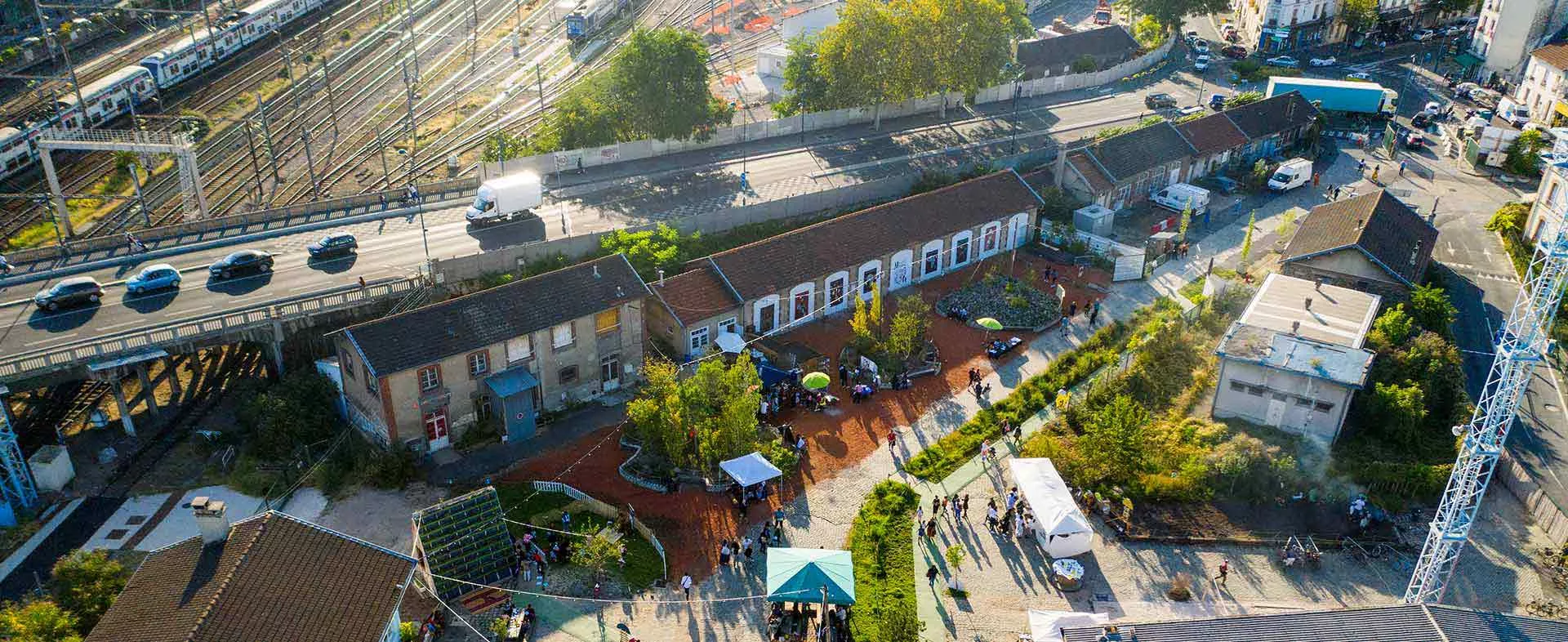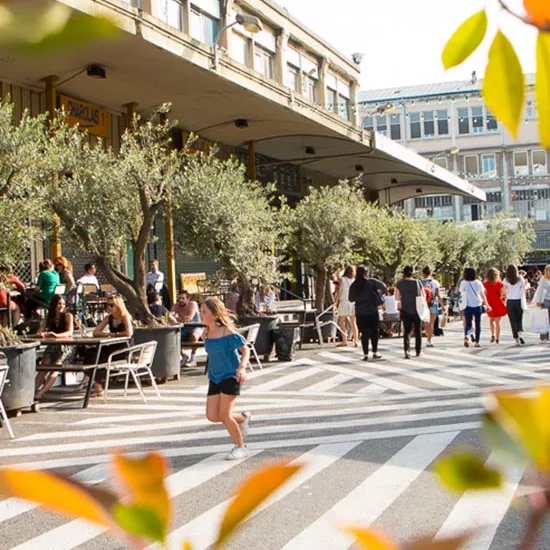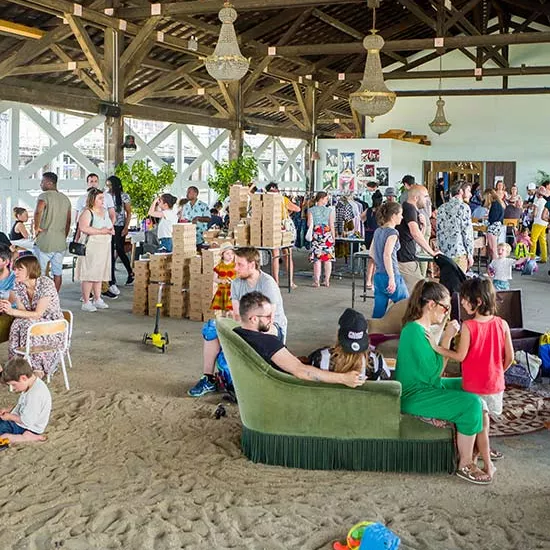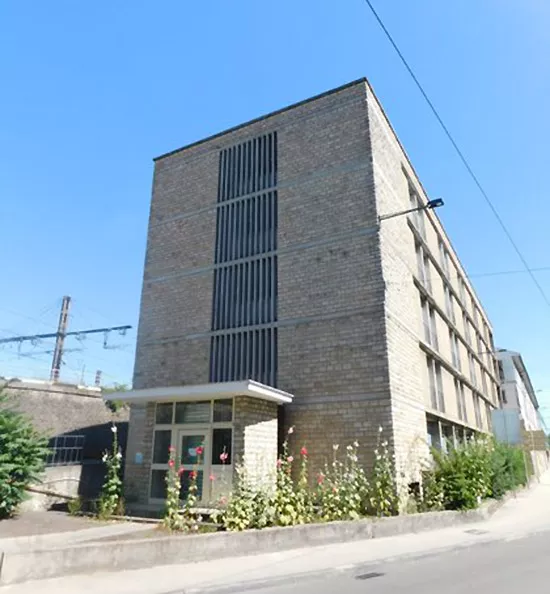
From transitional spaces to new cities
SNCF Immobilier transforms idle rail properties into social and cultural third places, injecting new life as they await redevelopment. Find out how.
Transitioning to a new life
When we create an interim space, we offer a glimpse of new use patterns that meet local needs and enrich urban planning. These experimental third places range from pop-ups to temporary and transitional spaces, but all are consistent with SNCF Group’s practice of social responsibility (CSR).
And we always work with partners. Our transitional projects are guided by dialogue with local communities and people living nearby, and they create a fun, sociable atmosphere that makes quality of life better for all.

We’ve welcomed
4 million
visitors to our transitional urban spaces

More than
400 jobs
have been created at these sites by our partners

We’ve launched
40 projects
and transformed 100,000 sq m since 2015
Transforming spaces nationwide
All of our third places—past, present and future—are closely linked to the identity, history, geography and potential of the sites that house them. In the 5 examples below, you’ll see how we give new appeal to these unused, sometimes forgotten spaces.

Ground Control – Paris
A former postal sorting facility near Paris-Lyon station has become a third place for creating and sharing culture and the arts. Espaces Ferroviaires will soon develop the site under the 6-ha Paris-Lyon station–Daumesnil–Les Messageries project.
Fast facts on Ground Control
- Project timeline: 2017-2024
- 2 million visitors
- 23 occupants: 18 businesses and 5 non-profits
- 100 jobs created, including 55 permanent ones
Trinquetaille – Arles
In 2018, this former SNCF maritime terminal hosted an exposition linked to the Rencontres d’Arles photography festival. The facility is set for transformation as part of a broader urban development project by the city.
Fast facts on Rencontres d’Arles and SNCF Immobilier
- 3,000-5,000 sq m of SNCF space has been used every summer since 2016
- a 1,200-sq m portable pavilion was created in the former Trinquetaille maritime terminal in 2018
Learn more about the Rencontres d’Arles photography festival

La Cité Fertile – Paris region
Our transitional site at this former freight station explored the cities of tomorrow and experimented with ecology, sustainability and creativity. It hosted a variety of third places promoting networking, training, and support for entrepreneurs.
Fast facts on La Cité Fertile
- 1 ha occupied by project leader Sinny & Ooko and an ecosystem of businesses—a craft brewery, local eateries, events and an urban farm
- 16 ha of urban land in all, now being redeveloped into an eco-district.

Quartier Libre – Rouen
For years, this 15-ha former freight facility has hosted a variety of cultural events as it awaits redevelopment. Starting in 2030, the site will be converted into a high-speed railway station and the new Saint-Sever district.
Fast facts on Quartier Libre
- From 2016 to 2018, the Lucien non-profit inaugurated the site with an exciting music programme on summer weekends.
- In 2019 La Friche Lucien—a festive, open-air third place for the arts—occupied the space from April to October.
- In 2021 we issued a call for projects to occupy the site until 2030.
- In 2022, La Friche Lucien was replaced by Quartier Libre, an 8,000-sq m, year-round venue with creative spaces, bars, restaurants and theatre.

Foyer Arquebuse – Dijon
Once a residence for railway workers, this building now offers 15 rooms as short- to medium-term emergency housing for the most vulnerable. The Dijon-based non-profit ADEFO also helps residents enter the job market.
Fast facts on Foyer Arquebuse
- 550 sq m of this 5-floor, 1,000-sq m building are occupied by the project
- 15 rooms have been converted into temporary housing
Innovating to meet social and environmental challenges
SNCF’s properties offer a wide range of locations and configurations—a powerful asset in creating the cities of tomorrow. We design new buildings around 4 core principles:
- convertibility
- mixed use
- the social and solidarity economy
- rewilding
Adapting to new use patterns
As use patterns change, a convertible building can adapt without requiring major modifications. To put this idea into practice, we launched our Temporary Urban Roofs programme—the first innovation partnership for housing and construction—with Banque des Territoires, a French development bank, and several other partners. This project aims to produce mobile, modular, competitively-priced buildings for sustainable, circular cities.
One space, multiple uses
Innovative design can combine work and residential spaces in a single venue. Third places such as Ground Control, La Cité Fertile, Le Shakirail and Lunel, and projects on the petite ceinture—an abandoned railway encircling Paris—are highly flexible and mix users and use patterns in the same space, midway between home and work. These projects generate value because they can adapt to new needs and life cycles, and weather shocks such as the Covid crisis.
Inclusive, energy-efficient new models
We’ve experimented with the social and solidarity economy (SSE) in multiple transitional urban development projects, including La Cité Fertile and Le Shakirail, both in Paris. One key component is the sharing economy, which emphasizes existing local resources, such as short distribution channels, fab labs and sustainable food. These experiments are generating new economic models with more inclusion and less environmental impact.
Preserving resources and biodiversity
Urban transformation projects give us the opportunity to rewild paved areas and reconvert them to open spaces, treating biodiversity and the soil as valuable resources that must be preserved. This is true for:
- future urban parks in redevelopment projects on SNCF land
- rooftop and underground urban farms
- plots of soil made available for urban agriculture